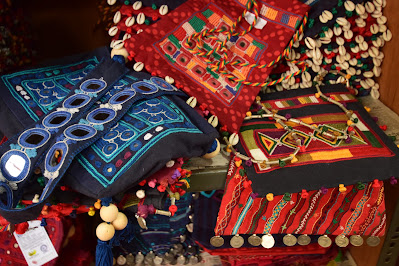Lambani Embroidery - an unknown tribe craft
Lambani is one of the Banjara Tribe. Banjara means the people who wonder in jungle and forest who sell forest produce in local villages. Lambani tribe moved from central Asia through Afghanistan or Kashmir into Rajasthan, Gujarat and South India. Amongst all tribes, Lambani’s outfits are most elegant and colorful in India. Lambani embroidery is one of the handicrafts of the Lambanis found in Sandur town of the Bellary district of Karnataka.
Lambani embroidery is a unique combination of thread work and mirror craft, which used to made by Lambani women specifically as the traditional wear for their own wedding or gift to their daughter on their wedding. This art contains mirrors, shells, coins and embroidery craft which make it unique from another type of embroideries.
Lambani Craft is done mostly in Cotton or Khadi fabrics which are bought from Tamil Nadu. These fabrics and yarn for embroidery are dyed with chemical or organic colors as per the design requirement. This dyed cloth is cut according to the design. Artisans finally make embroidery with yarn and decorate with different mirrors and seashells. Women artisans use 14 different types of stitches, thirteen colors (red and blue are common) and 10 types of motif designs for Lambani embroidery. Different types of stitches for embroidery are used by artisans like Kilian, Vele, Bakkya, Maki, Suryakanti Maki, Kans, Tera Dora, Kaudi, Relo, Gadri, Bhuriya, Pote, Jollya and Nakra. This embroidery covers the whole surface of the base cloth which is a signature pattern of it. The quilting technique is also a major part of Lambani embroidery. The patterns seen in embroidery are a reflection of the Lambani tribe’s life and surrounding. Most of the patterns are geometric such as circles, triangles, parallel lines and rectangles.
Artisans have explored in different products to reach contemporary markets like bed sheets, cushion covers, sling bags, purse, pouches, dupattas, home décor items, mobile phone covers and also ready to wear garments. Lambani embroidery work is attractive to tourists and the people who love vivid colors and handmade products. This art has reached all over the world with the export of different products like bedsheets and cushion covers, bags, etc. This distinct tribal art has also received the Geographic Indication tag in India.
In 1984, M.Y.Ghorpade, the former minister took initiative and supported this craft by establishing Sandur Kushala Kala Kendra (SKSS). It is a non-profit centre which works towards uplifting and introducing traditional crafts of the village to national and international levels. This centre is taking care of better livelihood for artisans and saving art from becoming distinct. Centre supplies the raw materials like fabric, threads and other accessories based on requirements and orders from the market. This Kendra is not only providing input support but also output supports like selling products, market support, innovation in design and guides them for working with market expectations. Artisans are also given the exposure it the latest design and fashion trends through government training institutions and Dastakar NGO. At present this centre is not only selling embroidery work but also cane and bamboo products, stone and wood carving, cotton khadi spinning and weaving products, etc. Sandur Kushala Kala Kendra employs both women and men and has over 500 artisans who are working under institute. SKSS is doing a commendable job in saving this tribal art and making it famous all over the world by promoting and exporting into different countries.





Comments
Post a Comment